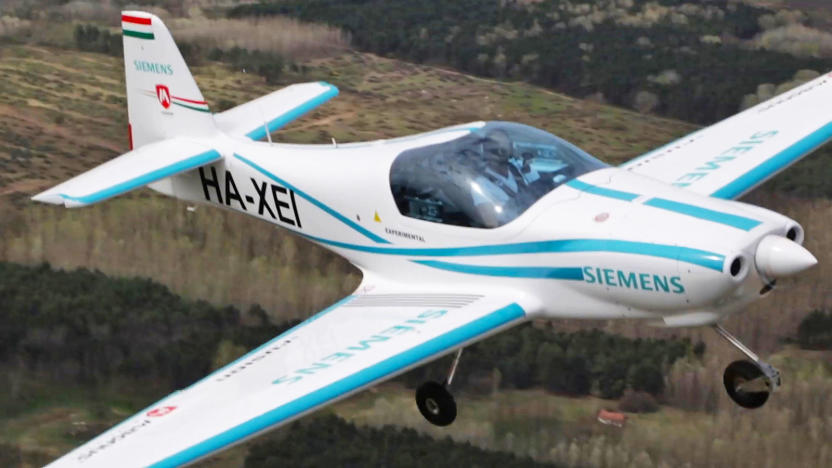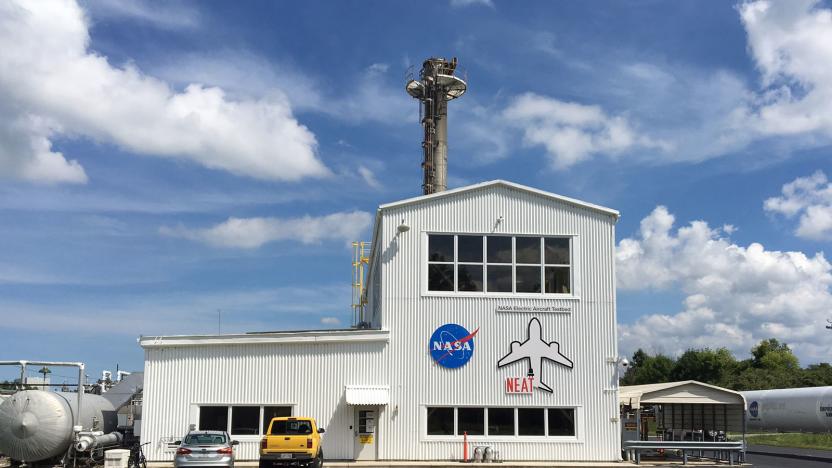ElectricPlane
Latest

Prototype electric plane crash kills two pilots
An electric plane powered by Siemens has crashed in southern Hungary, killing both pilots aboard, according to Siemens and local reports. The Magnus eFusion aircraft was flown as part of an inauguration for Magnus' new headquarters, but crashed near the airport after performing several circuits, police said. The eFusion is still a prototype, but Magnus, based in Hungary, plans to eventually commercialize and sell it for around $200,000.

Lilium secures $90 million to develop its electric VTOL plane
Like a few other startups, Lilium wants to make our flying car dreams come true with an electric VTOL craft you can summon with an app. Thanks to $90 million worth of new investment from China's Tencent and others, the startup may now have a leg up on its rivals. It will use the funds to drastically expand hiring in order to take the electric jet into the next stages of development.

NASA unveils a new testbed for electric aircraft
In order to hit its ambitious goal of transitioning aircraft to electric propulsion in the next ten years, NASA has announced a new research wing at the NASA Glenn Research Center's Plum Brook Station in Ohio. Meet NASA's Electric Aircraft Testbed -- or "NEAT" for short -- a new space for NASA Glenn engineers to design, develop and test electric aircraft like the like the GL–10 Greased Lightning VTOL and the LEAPTech wing.

Personal electric plane won't need an airport
Now that hoverboards are an honest-to-god thing, we have to say we're pretty disappointed with how flying cars have worked out. Another company has jumped into the fray with a vertical take-off plane called the Lilium that can soar at 400 km/h (250 mph). We'd normally say they're dreaming with the specs: A 10,000 foot ceiling, 500 km (310 mile) range and helicopter-like takeoffs, all on battery power. However, it's hosted by a European Space Agency (ESA) incubator and the team from the Technical University of Munich plans manned tests next year.

The Big Picture: NASA's electric plane achieves vertical takeoff
While EVs like the Tesla Model S and Renovo Coupe gain steam here on the ground, engineers at NASA's Langley Research Center are taking electric propulsion technology to new heights. What you see above is the GL-10 -- AKA Greased Lightning. This serious looking unmanned aerial system has a 10-foot wingspan and is powered by 10 individual electric motors with enough torque to propel it straight up in the air like a Harrier Jet. The GL-10 is nowhere near the size or weight of a Boeing V-22 Osprey, but that sort of maneuver is nonetheless impressive for a battery-powered machine.

Extra footage of record-setting Yates electric plane flight shows power loss, dramatic deadstick landing (video)
We've chronicled Flight of the Century founder and CEO Chip Yates' record-breaking 202.6MPH flight in his Long-ESA EV craft before. What we didn't quite touch on, however, is the power loss Yates' aircraft suffered after earning that electric plane speed record. Now Yates has released new video of the flight, which includes the moment his aircraft breaks the record, the ensuing power loss and his dramatic deadstick landing. That smile you see in the photo up there is the smile of a man who just made history and is also happy to be alive. Hey, we're glad he's safe, too. You can witness the close call yourself by checking out the video after the break. [Image credit: Flight of the Century]

FAA writing rules for electric aircraft, to allow public to fly them in the next decade
There are those in the general aviation community who think electric planes are the future for private aircraft, but regulatory hurdles are in place preventing them from proliferating in our skies. You see, current FAA requirements for light sport aircraft (LSA) -- planes that can be flown by anyone with a pilot's license -- preclude electric powerplants, and that makes such planes unavailable to most private pilots. Well, today at the CAFE Electric Aircraft Symposium, FAA analyst Tom Gunnarson delivered some good news for flying EV advocates, stating that the FAA has completed its regulatory study on electric aircraft, and the rulemaking process will begin soon. Once those rules have been written, electrically-propelled aircraft will be available for use as LSA by the public, which isn't possible today given their current status as experimental craft. The bad news? Governmental wheels spin slowly, and Gunnarson said that incorporating those new rules into the current regulatory framework will take five years if we're lucky, but ten years is a more likely time frame for the FAA to finish. In the meantime, you'll have to settle for air shows or terrestrial transport to get your EV fix.

PC-Aero ready to fly the Elektra One, Germany's latest electric-powered plane
Germany started with electric cars and bikes, and now it's taking things to the air with the PC-Aero Elektra One. This single-seat ultralight plane has a composite airframe, 16-kilowatt motor with a range of 400 kilometers and a max flight time of three hours. At a cruising speed of 160 km/h (about 99 mph for us anglophiles), the aircraft won't be setting any speed records, but given that it's being designed as an eco-friendly way to enjoy "leisure aviation," you should've expected it to travel at a leisurely pace, indeed. The Elektra One hasn't taken to the air just yet, but PC-Aero plans to perform the first flight test later this month, so we can look forward to seeing another electric plane flying overhead in the near future. Check the video after the break to see and hear the future of aviation for yourself.

Inhabitat's Week in Green: Tesla's Roadster 2.5, the world's smallest electric plane, and solar jellyfish goo
Each week our friends at Inhabitat recap the week's most interesting green developments and clean tech news for us -- it's the Week in Green. From the deep blue seas to the sunny skies, this week novel renewable energy projects lit up the newswires. We watched as the world's largest wave energy site was installed in the UK, and we were excited to see Europe's largest wind farm get a major upgrade. We also took a look at several high-flying turbines that could potentially tap 870 terawatts of high-altitude wind energy, and we were shocked to see scientists develop a new type of solar cell made from bioluminescent jellyfish. We also showcased several soaring advances in green aviation as the Solar Impulse sun-powered airplane rallied for a series of trips across Switzerland and Cri-Cri, the wold's smallest electric plane, took its inaugural flight. Electric transportation also hit the streets as we took a spin in Tesla's brand new Roadster 2.5. In other news, this week we saw the light as Hulger brought their stunningly sculpted Plumen bulbs to market, and we marveled at a fresh new solar panel-inspired clothing line and a photovoltaic roofing system that doesn't look like a Blade Runner prop. Finally, we celebrated the last days of summer with this awesome solar Ibex cooker that bakes and boils using the power of the sun.

Sonex unveils electric-powered sport plane
Aircraft maker Sonex and partner AeroConversions recently unveiled a slick little electric-powered, two-person sport aircraft called, um, the Sonex. The small yellow prototype was announced at a press conference held by the company on Tuesday. Sonex president John Monnett told the crowd that the plane was part of its E-Flight Initiative, and that the lightweight craft took flight using proprietary electric engine technology powered by ten "safe boxes," which contain eight Lithium-Polymer batteries each. The company hopes to extend the current flight time of 45 minutes to an hour by using more efficient versions of the batteries, and says it's exploring ethanol options as part of the initiative. There was no indication as to when the plane would be ready for sale, but Sonex did say that the final product will be "vastly less expensive than other things out there." Which we're pretty sure means Paul Moller better watch his back.[Via The Raw Feed]



